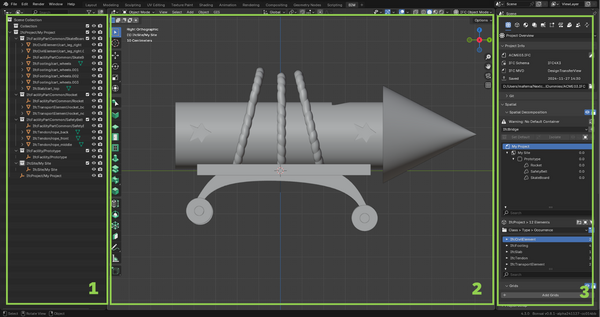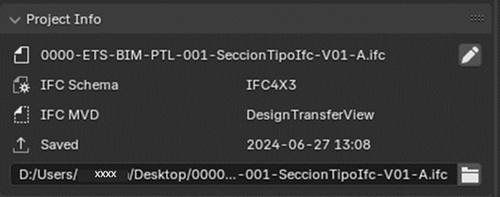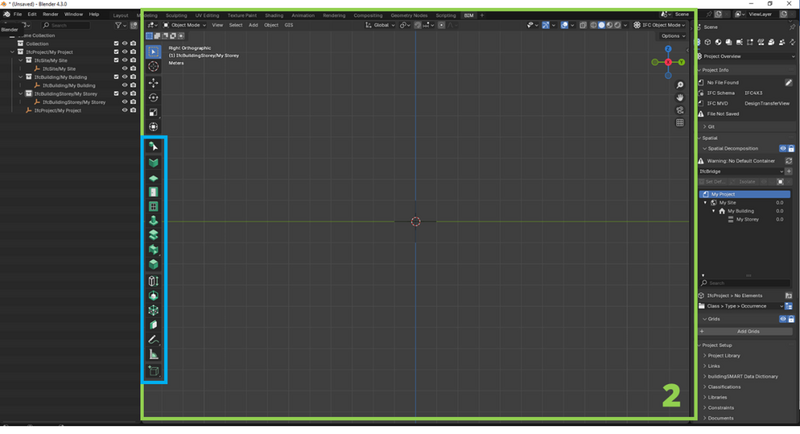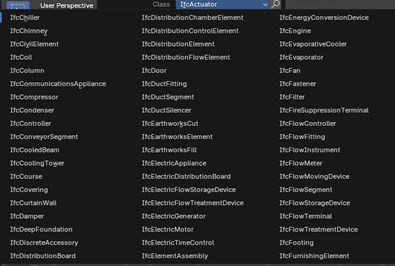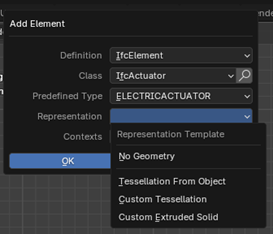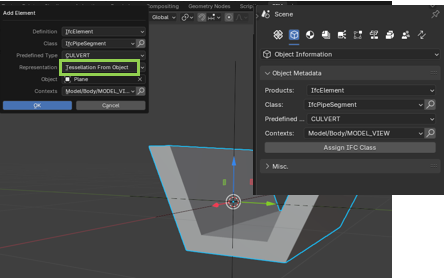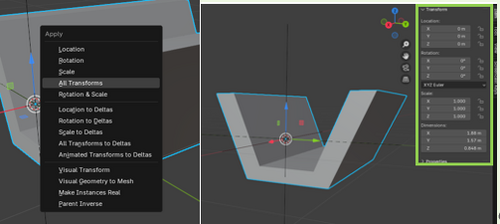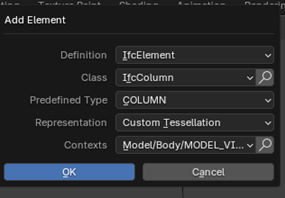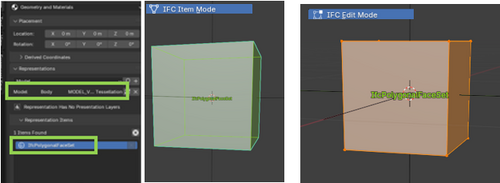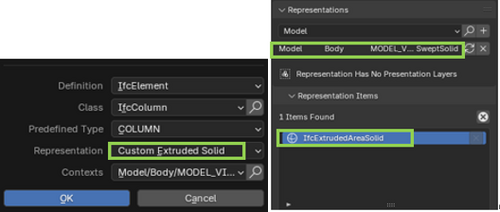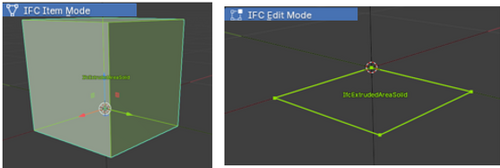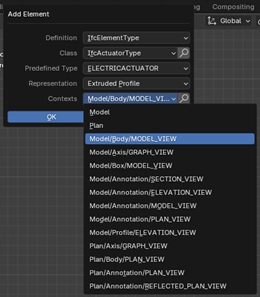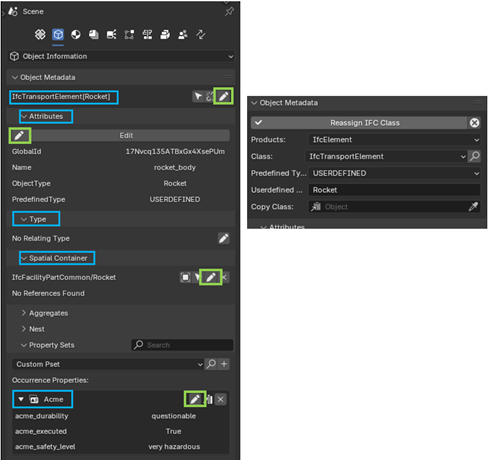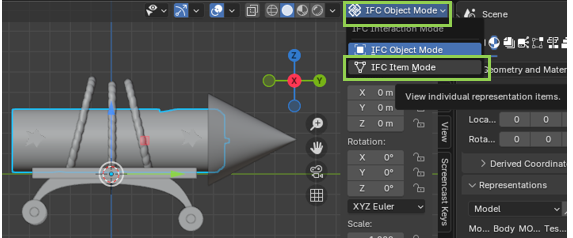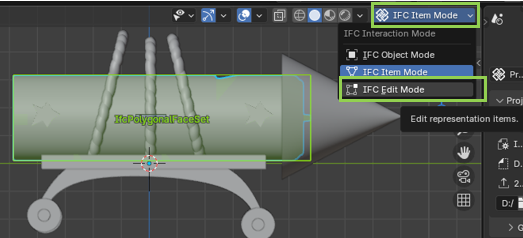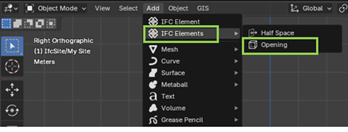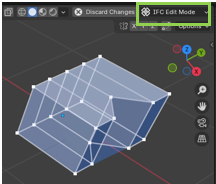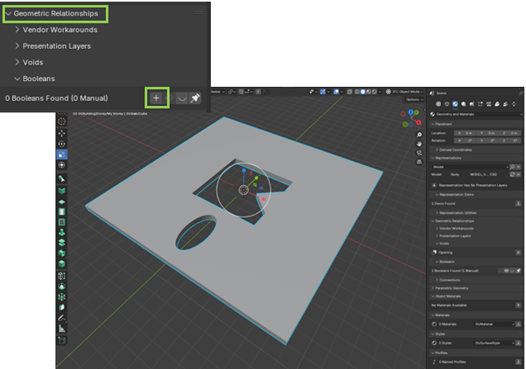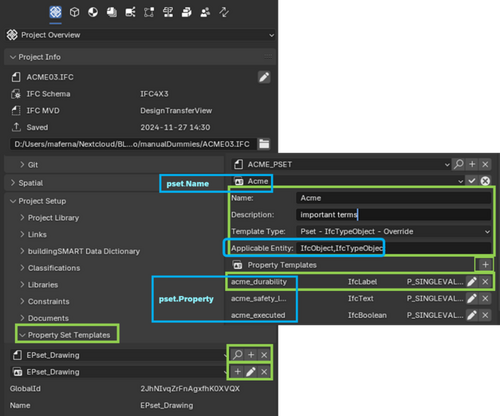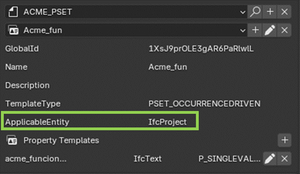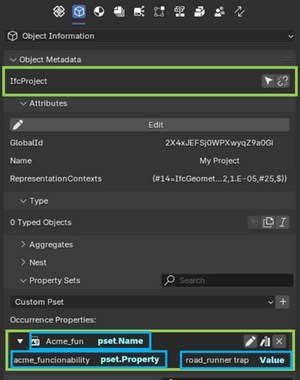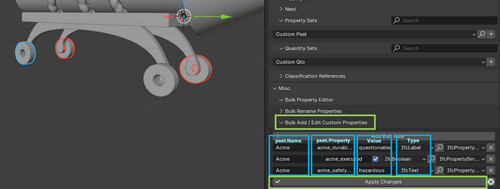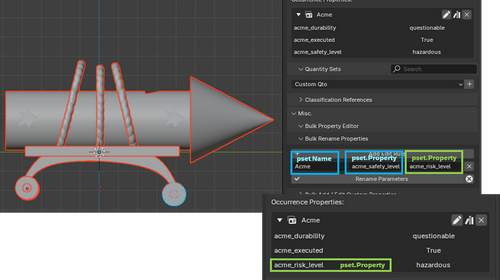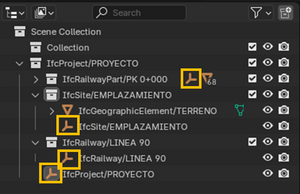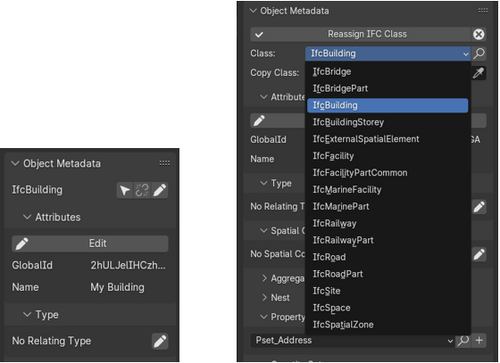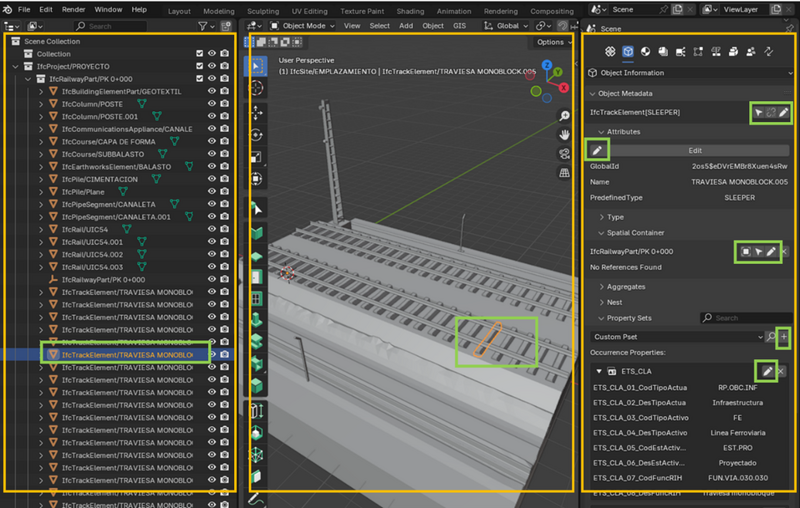Difference between revisions of "BlenderBIM Add-on/BonsaiBIM Features Guide"
| (20 intermediate revisions by the same user not shown) | |||
| Line 21: | Line 21: | ||
Main functions: | Main functions: | ||
* '''Project Info:''' Allows you to view general project information, such as the project name, author, and other key details that, while not the most exciting, are essential for keeping the model organized and making navigation easier. | * '''Project Info:''' Allows you to view general project information, such as the project name, author, and other key details that, while not the most exciting, are essential for keeping the model organized and making navigation easier. | ||
| − | [[File:Imagen2.png|thumb| | + | [[File:Imagen2.png|thumb|500px|center]] |
* '''Spacial Decomposition:''' Provides a structured map of the IFC model, allowing you to visualize and organize elements based on their spatial location within the project. | * '''Spacial Decomposition:''' Provides a structured map of the IFC model, allowing you to visualize and organize elements based on their spatial location within the project. | ||
| − | [[File:Imagen3.png|thumb| | + | [[File:Imagen3.png|thumb|500px|center]] |
* '''Property Sets (Pset) Templates:''' Enables the creation of templates for Property Sets to be used for each model element, simplifying the process of assigning attributes to elements. | * '''Property Sets (Pset) Templates:''' Enables the creation of templates for Property Sets to be used for each model element, simplifying the process of assigning attributes to elements. | ||
* '''Georeferencing:''' Configures the model's geographic location to ensure it is accurately placed in the real world. | * '''Georeferencing:''' Configures the model's geographic location to ensure it is accurately placed in the real world. | ||
| Line 79: | Line 79: | ||
</div> | </div> | ||
| − | |||
== EXPLORING AN IFC== | == EXPLORING AN IFC== | ||
| Line 152: | Line 151: | ||
Go to the '''Definition''' section. Here, you will select the entities that will classify your object. | Go to the '''Definition''' section. Here, you will select the entities that will classify your object. | ||
| − | [[File:Imagen9.png|thumb| | + | [[File:Imagen9.png|thumb|500px|center]] |
If you have doubts about an entity, hover the cursor over it to see a brief description. | If you have doubts about an entity, hover the cursor over it to see a brief description. | ||
| − | [[File:Imagen10.png|thumb| | + | [[File:Imagen10.png|thumb|500px|center]] |
In the '''Class''' section, you will classify your object within the selected entities. The options are listed alphabetically for easier searching. | In the '''Class''' section, you will classify your object within the selected entities. The options are listed alphabetically for easier searching. | ||
| − | [[File:Imagen11.png|thumb| | + | [[File:Imagen11.png|thumb|500px|center]] |
In the '''Representation''' section, you will define how your object will be visualized. The available options are: | In the '''Representation''' section, you will define how your object will be visualized. The available options are: | ||
| − | [[File:Imagen12.png|thumb| | + | [[File:Imagen12.png|thumb|500px|center]] |
1. '''No Geometry''': The object will have no graphical representation. Suitable for purely informational elements. | 1. '''No Geometry''': The object will have no graphical representation. Suitable for purely informational elements. | ||
| Line 171: | Line 170: | ||
2. '''Tessellation From Object''': Uses an object created in Blender. Ideal for custom designs, such as beams, gutters, or walls with complex shapes. | 2. '''Tessellation From Object''': Uses an object created in Blender. Ideal for custom designs, such as beams, gutters, or walls with complex shapes. | ||
| − | [[File:Imagen13.png|thumb| | + | [[File:Imagen13.png|thumb|500px|center]] |
| − | [[File:Imagen14.png|thumb| | + | [[File:Imagen14.png|thumb|500px|center]] |
<div style="margin-left: 100px; text-align: justify;"> | <div style="margin-left: 100px; text-align: justify;"> | ||
| Line 179: | Line 178: | ||
'''''Tip''': After modifying your object in Blender, press '''Ctrl+A''' and select '''Apply All Transforms''' to avoid future issues.'' | '''''Tip''': After modifying your object in Blender, press '''Ctrl+A''' and select '''Apply All Transforms''' to avoid future issues.'' | ||
| − | [[File:Imagen15.png|thumb| | + | [[File:Imagen15.png|thumb|500px|center]] |
</div> | </div> | ||
3. '''Custom Tessellation''': Allows for advanced and customized representation. | 3. '''Custom Tessellation''': Allows for advanced and customized representation. | ||
| − | [[File:Imagen16.png|thumb| | + | [[File:Imagen16.png|thumb|500px|center]] |
| − | [[File:Imagen17png.png| | + | [[File:Imagen17png.png|500px|thumb|center]] |
4. '''Custom Extruded Solid''': Recommended for linear shapes that require extrusion. | 4. '''Custom Extruded Solid''': Recommended for linear shapes that require extrusion. | ||
| − | [[File:Imagen18.png| | + | [[File:Imagen18.png|500px|thumb|center]] |
| − | [[File:Imagen19.png| | + | [[File:Imagen19.png|500px|thumb|center]] |
In the '''Contexts''' section, you will define the context in which your object will be used. This step completes the model definition process. | In the '''Contexts''' section, you will define the context in which your object will be used. This step completes the model definition process. | ||
| − | [[File:Imagen20.png| | + | [[File:Imagen20.png|500px|thumb|center]] |
For a better understanding of how to use this tool, it is recommended to watch this video, which clearly explains how to create a building: [https://www.youtube.com/watch?v=pQnJ-5b3_Kg Watch video]. | For a better understanding of how to use this tool, it is recommended to watch this video, which clearly explains how to create a building: [https://www.youtube.com/watch?v=pQnJ-5b3_Kg Watch video]. | ||
| Line 215: | Line 214: | ||
[[File:Imagen21.png|700px|thumb|center]] | [[File:Imagen21.png|700px|thumb|center]] | ||
| − | |||
| − | |||
=== Modifying Position === | === Modifying Position === | ||
1. Go to the '''Geometry and Materials''' tab. | 1. Go to the '''Geometry and Materials''' tab. | ||
| + | |||
2. In the '''Placement''' dropdown, adjust the position or rotation of the object. | 2. In the '''Placement''' dropdown, adjust the position or rotation of the object. | ||
| + | |||
3. For a visual approach, use Blender's Gizmo to move the object. Ensure the changes are reflected in the '''Placement''' dropdown; otherwise, the changes will not be saved. | 3. For a visual approach, use Blender's Gizmo to move the object. Ensure the changes are reflected in the '''Placement''' dropdown; otherwise, the changes will not be saved. | ||
| Line 293: | Line 292: | ||
<u>'''Purpose of Psets'''</u> | <u>'''Purpose of Psets'''</u> | ||
Psets serve two primary purposes: | Psets serve two primary purposes: | ||
| − | + | ||
| − | + | * Standardization: They ensure that all projects follow the same logic and structure, promoting consistency across designs. | |
| + | |||
| + | * Ease of Analysis: They allow for efficient filtering and analysis of specific elements. Without custom Psets, navigating through data would be like searching for a needle in a haystack. | ||
===Adding Custom Psets to Your Model=== | ===Adding Custom Psets to Your Model=== | ||
| Line 302: | Line 303: | ||
<u>'''Step 1: Create a Property Set Template'''</u> | <u>'''Step 1: Create a Property Set Template'''</u> | ||
1. Navigate to the '''Property Set Templates''' tab. | 1. Navigate to the '''Property Set Templates''' tab. | ||
| − | [[File:Imagen31.png| | + | [[File:Imagen31.png|500px|thumb|center]] |
2. Create a template for custom Property Sets (Psets) to tailor them to specific user or project requirements. | 2. Create a template for custom Property Sets (Psets) to tailor them to specific user or project requirements. | ||
<u>'''Step 2: Define Applicable Entities'''</u> | <u>'''Step 2: Define Applicable Entities'''</u> | ||
- Specify the entity to which the Pset applies using the '''ApplicableEntity''' field. For example, if the Pset is relevant to the entire project, indicate this in the field. | - Specify the entity to which the Pset applies using the '''ApplicableEntity''' field. For example, if the Pset is relevant to the entire project, indicate this in the field. | ||
| − | [[File:Imagen32.png| | + | [[File:Imagen32.png|300px|thumb|center]] |
<u>'''Step 3: Save Custom Properties'''</u> | <u>'''Step 3: Save Custom Properties'''</u> | ||
- Custom properties must be saved in the following directory: | - Custom properties must be saved in the following directory: | ||
C:\Users\usuario\AppData\Roaming\Blender Foundation\Blender\4.2\extensions\.local\lib\python3.11\site-packages\bonsai\bim\data\pset | C:\Users\usuario\AppData\Roaming\Blender Foundation\Blender\4.2\extensions\.local\lib\python3.11\site-packages\bonsai\bim\data\pset | ||
| + | - These properties can be reused in other projects that require them. | ||
| + | </div> | ||
| + | |||
| + | <u>'''Additional Resources'''</u> | ||
| + | For further guidance, refer to this tutorial: | ||
| + | [https://www.youtube.com/watch?v=nlSM593swZY Watch video] | ||
| + | |||
| + | === Adding Psets: Individually or in Bulk === | ||
| + | |||
| + | Psets (Property Sets) can be added to your model either individually or in bulk, depending on your workflow and the stage of your project. | ||
| − | + | ==== Adding Psets Individually ==== | |
| + | If you are modeling from scratch and prefer a meticulous, step-by-step approach, you can add Psets to each element individually. Follow these steps: | ||
| + | 1. Go to the '''Object Information''' tab. | ||
| + | |||
| + | 2. Open the '''Property Sets''' dropdown. | ||
| + | |||
| + | 3. Under '''Custom Pset''', select the template you previously created. | ||
| + | |||
| + | 4. Fill in the values for the properties included in your template. | ||
| + | |||
| + | [[File:Imagen33.png|500px|thumb|center]] | ||
| + | |||
| + | This method is ideal for detailed work or when your model is still in its early stages. It works the same way for the '''IfcProject''' entity. | ||
| + | |||
| + | [[File:Imagen34.png|300px|thumb|center]] | ||
| + | |||
| + | ==== Adding Psets in Bulk ==== | ||
| + | For projects with hundreds of similar elements, the bulk method saves time and effort. Here’s how to do it: | ||
| + | 1. Go to the '''Object Information''' tab. | ||
| + | |||
| + | 2. Navigate to the '''Misc.''' (miscellaneous) dropdown and select '''Bulk Property Editor'''. | ||
| + | |||
| + | 3. From here, you can: | ||
| + | |||
| + | * Rename properties: Change the names of properties without altering their values. | ||
| + | * Add or edit properties: Enter the Pset name, property, and value. Ensure you specify the entity type used in your template. | ||
| + | * Remove properties: Delete properties that are no longer needed. | ||
| + | |||
| + | 4. Select all the objects to which you want to apply these changes. | ||
| + | |||
| + | 5. Click on '''Apply Changes'''. The changes will be applied to all selected objects. | ||
| + | |||
| + | [[File:Imagen35.png|500px|thumb|center]] | ||
| + | |||
| + | ==== Important Notes ==== | ||
| + | * Editing Properties: When editing properties, the object will only retain the properties you list. If you include only one property, the rest will be removed. Ensure you include all necessary properties to avoid data loss. | ||
| + | * Renaming vs. Editing: Renaming only changes the name of the property. To edit values, use the '''Edit''' function. Properly managing your Psets will ensure the accuracy and integrity of your model. | ||
| + | |||
| + | [[File:Imagen36.png|500px|thumb|center]] | ||
= '''IFC MANAGEMENT''' = | = '''IFC MANAGEMENT''' = | ||
== (Re)Organizing the Model == | == (Re)Organizing the Model == | ||
| − | |||
| − | + | A well-structured IFC schema is a cornerstone of effective Building Information Modeling (BIM). It ensures that data is organized, consistent, and reusable across all stages of a project. Proper management of IFC schemas allows for: | |
| − | ( | + | |
| + | * Efficient data handling: Simplifies data management and reduces errors. | ||
| + | * Improved collaboration: Ensures all stakeholders work with standardized and reliable data. | ||
| + | * Enhanced project outcomes: Minimizes last-minute changes and supports better decision-making. | ||
| + | |||
| + | <u>'''Working with Zone 1: Selecting and Editing Elements'''</u> | ||
| + | |||
| + | The first step in managing your IFC model is to understand how to interact with elements in '''Zone 1'''. This zone is where you select and edit the two main types of elements in your model: | ||
| + | |||
| + | 1. '''Containers''': | ||
| + | |||
| + | These are hierarchical elements that organize your model, such as '''IfcBuilding''', '''IfcRailway''', '''IfcBuildingStorey''', and '''IfcRailwayPart'''. | ||
| + | |||
| + | To edit a container, select the null element (represented by the symbol of three connected bars). This allows you to modify properties or adjust its position within the hierarchy. | ||
| + | |||
| + | [[File:Imagen37.png|300px|thumb|center]] | ||
| + | |||
| + | 2. '''3D Objects''': | ||
| + | '''These are the physical components of your model, such as '''IfcDoor''', '''IfcSlab''', '''IfcFooting''', and others. | ||
| + | To edit a 3D object, simply select it directly in the viewport or the object list.''' | ||
| + | |||
| + | <u>'''Organizing and Refining Your Model in Zone 3'''</u> | ||
| + | |||
| + | Once you have selected an element in '''Zone 1''', you can further organize and refine it in '''Zone 3'''. This zone provides tools for managing the hierarchical structure and properties of your model. | ||
| + | |||
| + | '''Spatial Decomposition (Hierarchy Tree)''' | ||
| + | |||
| + | Navigate to '''Project Overview → Spatial Decomposition''' to access the hierarchical tree. This tree acts as an organizational chart for your model, allowing you to: | ||
| + | |||
| + | * Add new levels: Useful if your project expands or requires additional subdivisions. | ||
| + | * Remove unnecessary levels: Helps reduce clutter and streamline the model structure. | ||
| + | |||
| + | [[File:Imagen38.png|700px|thumb|center]] | ||
| + | |||
| + | '''Changing Entity Types''' | ||
| + | If you need to modify the entity type of an element (e.g., changing a wall to a slab): | ||
| + | 1. Go to '''Object Information → Object Metadata'''. | ||
| + | 2. Select the element you want to edit. | ||
| + | 3. Adjust its classification or rename it directly in the '''Attributes''' section. This ensures that elements are correctly labeled and categorized. | ||
| + | |||
| + | [[File:Imagen39.png|500px|thumb|center]] | ||
| + | |||
| + | '''Editing 3D Objects''' | ||
| + | For 3D objects that are not correctly mapped or classified: | ||
| + | |||
| + | 1. Select the "▽" symbol in '''Zone 1'''. This highlights the object in '''Zone 2'''. | ||
| + | |||
| + | 2. In '''Zone 3''', you can: | ||
| + | |||
| + | * Assign the correct IFC class: Ensures the object is classified according to IFC standards. | ||
| + | * Rename the object: Avoids generic or unclear naming conventions. | ||
| + | * Place it in the appropriate level: Organizes the object within the hierarchy tree. | ||
| + | * Add or adjust properties: Enhances the object's metadata for better project management. | ||
| + | |||
| + | [[File:Imagen40.png|800px|thumb|center]] | ||
| + | |||
| + | <u>'''Best Practices for IFC Schema Management'''</u> | ||
| + | |||
| + | To ensure your IFC schema remains consistent and effective: | ||
| + | * Standardize naming conventions: Use clear and consistent names for all elements and properties. | ||
| + | * Regularly review the hierarchy: Keep the spatial decomposition tree organized and up-to-date. | ||
| + | * Validate data frequently: Use IFC validation tools to check for errors or inconsistencies. | ||
| + | * Document changes: Maintain a log of modifications to track updates and ensure transparency. | ||
== Federating and Merging == | == Federating and Merging == | ||
Latest revision as of 08:41, 7 April 2025
INTERFACE AND OPENING IFC MODELS[edit]
BONSAI INTERFACE OVERVIEW[edit]
The Bonsai interface is organized into three main areas, each with a specific function. These areas work together seamlessly to provide a complete environment for the design, editing, and management of IFC models.
Zone 1: IFC Entity Tree (Left Panel) The IFC Entity Tree displays a hierarchical list of all the IFC entities in your model. From this panel, you can explore and select any part of the model to edit. If you cannot find an element in the model, use the search function to locate it quickly.
Zone 2: 3D Geometry Visualization (Central Area) The IFC model is displayed in 3D in this area, allowing you to manipulate and analyze it. You can rotate, zoom, and select elements to inspect them from different perspectives. Using keyboard shortcuts, such as holding Shift to rotate faster, helps improve navigation within the model.
Zona 3: Non-Graphical Data of the 3D Model (Right Panel) This panel provides access to the non-graphical information of the model to ensure proper documentation. The information is organized into tabs that group various essential data sets related to the model. Below is an overview of each tab:
Project Overview tab provides general project information in a centralized view, reducing the need for multiple tools. It serves as a reference point for understanding the overall context of the IFC model. Main functions:
- Project Info: Allows you to view general project information, such as the project name, author, and other key details that, while not the most exciting, are essential for keeping the model organized and making navigation easier.
- Spacial Decomposition: Provides a structured map of the IFC model, allowing you to visualize and organize elements based on their spatial location within the project.
- Property Sets (Pset) Templates: Enables the creation of templates for Property Sets to be used for each model element, simplifying the process of assigning attributes to elements.
- Georeferencing: Configures the model's geographic location to ensure it is accurately placed in the real world.
- Model Element Filtering: Allows advanced filtering criteria to search and organize elements in large models, making it easier to find and organize elements efficiently.
- Model Federation: Enables the integration of multiple IFC models into a single workspace, ensuring proper coordination between different models and data sources.
- buildingSMART Data Dictionary: Provides access to a standardized dictionary that defines terms and attributes, ensuring everyone works with the same BIM language.
- Classifications: Activates classifications for model elements, helping with organization and preventing confusion when identifying different element types (e.g., a wall versus a door).
Object Information tab allows you to manage all the details of each element in the IFC model. You can access key information about each object and control everything related to its structure and properties.
Main functions:
- Element Data: Provides all the information about each object, such as its IFC class, indicating the type of entity (wall, window, column, etc.). It’s like having a detailed record of each element.
- Property Sets (Pset): Property Sets are detailed characteristics of each object, such as dimensions or technical specifications. This tool allows you to customize the model based on the project needs.
- Quantity Sets: Quantity Sets provide information about the material used in the model, allowing you to make precise measurements for material estimations.
In summary, Object Information is where you manage and access all the crucial information for each element in the model, enabling full control and easy adjustments or verifications.
Geometry and Materials tab allows you to manage both the geometry of model elements and their material properties. Here, you can modify the size, shape, and position of elements, as well as adjust their physical characteristics such as textures, colors, and technical properties (e.g., density or thermal conductivity). This tab also provides tools for working with parametric models, enabling precise adjustments and element replication.
Main functions:
- Geometry: Allows you to change the size, shape, and position of any element. You can adjust details like moving a column to a different location.
- Parametrization: For parametric models, this tool enables precise adjustments of dimensions or the duplication of elements quickly.
- Materials: Assign materials with textures, colors, and physical properties. You can define whether walls are rough or shiny, or whether the roof reflects light. Technical properties like density (weight) or thermal conductivity (ability to retain heat) can also be defined.
Drawings and Documents tab allows you to generate plans, drawings, and documents from the 3D model. Here, you can create 2D plans with different views, customize their details, and export them to common formats. Below are the main features:
- Create Drawings: Generate 2D plans from your 3D model, including sections, floor plans, elevations, and sections. You can customize aspects like scale, levels of detail, line thickness, and colors.
- Annotate and Label: Add dimensions, labels, and explanatory notes to the plans to detail dimensions, materials, and other important project aspects.
- Generate Documents: Export plans to formats like PDF or DWG for sharing with your team. You can also customize the plans with your logo, headers, and title blocks, and organize plans into sets ready for printing or sending to the client.
Services and Systems tab allows you to manage all technical building systems that are not part of the main structure but are essential for its operation, such as electricity, plumbing, heating, ventilation, and security systems.Below are the main features:
- Definition and management of systems: Create and organize technical systems such as electricity, HVAC (heating, ventilation, and air conditioning), plumbing, and fire alarms. Each system can have specific properties to ensure proper integration into the building design.
- Equipment and device assignment: Insert and configure the equipment required for system functionality, such as fans, pumps, sockets, and thermostats. Verify the specifications of each device to ensure compatibility and optimal placement.
Structural Analysis tab allows you to define and analyze the structural conditions of an IFC model, ensuring its stability against various loads and external forces.
Main Features:
- Define loads and forces: Configure the loads the building must withstand, including the weight of occupants, furniture, wind, snow, and seismic events. Assign these loads to structural elements such as beams and columns.
- Define boundary conditions: Specify the building's interactions with its environment by defining constraints and support points that affect its structural behavior.
Facility Management tab allows you to plan and organize the maintenance of building systems and equipment, ensuring their proper operation over time.
Main Features:
- Maintenance management: Schedule and manage inspections and repairs for various building systems and equipment. Define the frequency of maintenance tasks to ensure efficient and safe operations.
- Asset and inventory management: Track building equipment and installations while maintaining an up-to-date inventory of spare parts and materials required for maintenance.
Quality and Coordination tab provides essential tools for optimizing and analyzing IFC models. It streamlines conflict detection, data integration, and model refinement to enhance overall project quality and functionality.
Main Features:
- Model refinement: Clean and organize the IFC model to improve efficiency and handling.
- Automation tools: Small utilities for element extraction, data retrieval, and model merging.
- Clash Detection: Identify and manage conflicts between elements to avoid construction issues.
- BCF file management: Simplify problem tracking and resolution through efficient exchange of comments and annotations.
EXPLORING AN IFC[edit]
(Details on how to start with an IFC model)
DESIGN AND EDITING OF IFC[edit]
BASIC DESIGN TOOLS[edit]
Exploring the Bonsai Dropdown Menu[edit]
In section 2 of the interface, you will find a dropdown menu containing a series of icons. Each icon represents a predefined IfcElementType, such as walls, windows, or other construction elements. These elements serve as the basis for design: by assigning them a geometric shape, they automatically become the selected IfcElement.
This menu is primarily focused on building elements, but it also allows for the creation of generic elements.
Difference between IfcElementType and IfcElement
IfcElementType
- Definition: An IfcElementType is a template or generic definition of an element. It describes the common properties and behavior of a type of element but does not represent a specific instance in a project.
- Purpose: It is used to define the general characteristics of a type of element, such as a wall, window, or door. For example, an IfcWallType could define the common properties of all walls of a certain type (dimensions, materials, etc.).
- Usage: It is used to create specific instances of elements (IfcElement) in a project. In other words, an IfcElementType is like a "mold" that can be used multiple times to create concrete elements.
- Example: An IfcWindowType could define a type of window with standard dimensions and a specific material. This type can be used to create multiple windows (IfcWindow) in a building.
IfcElement
- Definition: An IfcElement is a specific instance of an element in a project. It represents a real and concrete object within a BIM model.
- Purpose: It defines the properties and geometry of an individual element in a specific context. For example, a particular window in a specific wall of a building.
- Usage: It is created from an IfcElementType, inheriting its general properties, but it can also have additional properties specific to that instance.
- Example: An IfcWindow created from an IfcWindowType could have a specific location in a wall, an adjusted size, and unique properties such as an identifier or an associated cost.
Relationship between IfcElementType and IfcElement
- An IfcElementType is a generic definition, while an IfcElement is a specific instance based on that definition.
- IfcElementType acts as a template that defines common properties, and IfcElement is the materialization of that template in a BIM model.
Summary in a Table
| Characteristic | IfcElementType | IfcElement |
|---|---|---|
| Nature | Template or generic definition. | Specific instance in a project. |
| Purpose | Defines common properties of a type. | Represents a real object in a BIM model. |
| Example | IfcWallType (type of wall). | IfcWall (specific wall in a building). |
| Relationship | It is the basis for creating IfcElement. | It is derived from an IfcElementType. |
Practical Example
IfcWallType: Defines a type of wall with a thickness of 20 cm and a concrete material.
IfcWall: Creates a specific wall in a building, using the IfcWallType as a base but with a specific location and length.
Creating Generic Elements[edit]
Go to the Definition section. Here, you will select the entities that will classify your object.
If you have doubts about an entity, hover the cursor over it to see a brief description.
In the Class section, you will classify your object within the selected entities. The options are listed alphabetically for easier searching.
In the Representation section, you will define how your object will be visualized. The available options are:
1. No Geometry: The object will have no graphical representation. Suitable for purely informational elements.
2. Tessellation From Object: Uses an object created in Blender. Ideal for custom designs, such as beams, gutters, or walls with complex shapes.
Tip: After modifying your object in Blender, press Ctrl+A and select Apply All Transforms to avoid future issues.
3. Custom Tessellation: Allows for advanced and customized representation.
4. Custom Extruded Solid: Recommended for linear shapes that require extrusion.
In the Contexts section, you will define the context in which your object will be used. This step completes the model definition process.
For a better understanding of how to use this tool, it is recommended to watch this video, which clearly explains how to create a building: Watch video.
Modifying Data and Elements in Bonsai[edit]
Sometimes, it is necessary to modify the data of elements. This may be due to errors, design changes, or simply personal preference. Bonsai allows these modifications to be made easily.
Modifying data[edit]
From the Object Information tab, in the Object Metadata dropdown, the following actions can be performed:
- Reassign IFC classification: Change the IFC classification of an element.
- Modify attributes such as name or type: Update the name or type of the element to improve its identification.
- Change its spatial container: Move the element to another level or section of the project using Spatial Container.
- Edit user-generated Psets: Adjust previously created custom data. This topic will be covered in more detail later.
Modifying Position[edit]
1. Go to the Geometry and Materials tab.
2. In the Placement dropdown, adjust the position or rotation of the object.
3. For a visual approach, use Blender's Gizmo to move the object. Ensure the changes are reflected in the Placement dropdown; otherwise, the changes will not be saved.
Modifying Geometry[edit]
1. Select the object you want to modify. 2. Go to the IFC Object Mode dropdown and select IFC Item Mode.
3. Select the object again and, in the same dropdown, choose IFC Edit Mode.
4. You are now ready to edit the geometry.
Tip: Always edit in IFC Object Mode, not in Blender's standard editor.
Creating Openings in Your Designs[edit]
If you need to add openings, such as doors, connections between floors, or drains in slabs, follow these steps to create them accurately.
Option 1: Creating Voids[edit]
1. Create an Opening Element: Go to: Menu > Add > Ifc Element > Opening. This generates an empty element in your design, which will serve as the mold for the opening.
2. Adjust the mold to your needs: Edit the shape of the Opening as if it were an IFC object (i.e., define its size and shape precisely). It can be round, square, or any other required shape.
3. Integrate the opening into your design: First, select the object where you want to create the opening (e.g., a slab, wall, etc.). Then, select the Opening Element (the void you created). Go to the Geometry and Materials tab, open the Geometric Relationships dropdown, and click on Voids > Add Opening.
The opening is now correctly integrated into the design.
Option 2: Boolean Method[edit]
For a more manual approach, you can use Boolean method to create openings.
1. Create the object that will serve as the cutter: Design a cylinder, cube, or any shape you need for the opening in Blender. This object will act as the cutter.
2. Select the objects: First, select the cutter object. Then, select the object where you want to create the opening (e.g., a wall, slab, etc.).
3. Perform the Boolean operation: Go to the Geometry and Materials tab. Open the Geometric Relationships dropdown and select Booleans > Add.
The opening is now created with precision.
Pset: Add, modify, or delete Property Set[edit]
What are Psets?
Psets, or Property Sets, are collections of data associated with the elements of your model. They do not refer to geometric properties (such as shapes or dimensions) but rather to the characteristics that describe how elements behave or their specific specifications.
Types of Property Sets in IFC
Property Sets in IFC are generally grouped into two categories:
1. Standard Psets: Defined by IFC standards and widely accepted in the AEC industry. Examples include:
- Pset_WallCommon (for walls). - Pset_WindowCommon (for windows). - Pset_SpaceOccupancyRequirements (for space occupancy requirements).
2. Custom Psets: Created specifically for a project or organization to meet particular needs. These are tailored to unique requirements and are not part of the standard IFC definitions.
Purpose of Psets Psets serve two primary purposes:
- Standardization: They ensure that all projects follow the same logic and structure, promoting consistency across designs.
- Ease of Analysis: They allow for efficient filtering and analysis of specific elements. Without custom Psets, navigating through data would be like searching for a needle in a haystack.
Adding Custom Psets to Your Model[edit]
To include user-defined Psets (Property Sets) in your model, follow these steps:
Step 1: Create a Property Set Template 1. Navigate to the Property Set Templates tab.
2. Create a template for custom Property Sets (Psets) to tailor them to specific user or project requirements.
Step 2: Define Applicable Entities - Specify the entity to which the Pset applies using the ApplicableEntity field. For example, if the Pset is relevant to the entire project, indicate this in the field.
Step 3: Save Custom Properties - Custom properties must be saved in the following directory: C:\Users\usuario\AppData\Roaming\Blender Foundation\Blender\4.2\extensions\.local\lib\python3.11\site-packages\bonsai\bim\data\pset - These properties can be reused in other projects that require them.
Additional Resources For further guidance, refer to this tutorial: Watch video
Adding Psets: Individually or in Bulk[edit]
Psets (Property Sets) can be added to your model either individually or in bulk, depending on your workflow and the stage of your project.
Adding Psets Individually[edit]
If you are modeling from scratch and prefer a meticulous, step-by-step approach, you can add Psets to each element individually. Follow these steps: 1. Go to the Object Information tab.
2. Open the Property Sets dropdown.
3. Under Custom Pset, select the template you previously created.
4. Fill in the values for the properties included in your template.
This method is ideal for detailed work or when your model is still in its early stages. It works the same way for the IfcProject entity.
Adding Psets in Bulk[edit]
For projects with hundreds of similar elements, the bulk method saves time and effort. Here’s how to do it: 1. Go to the Object Information tab.
2. Navigate to the Misc. (miscellaneous) dropdown and select Bulk Property Editor.
3. From here, you can:
- Rename properties: Change the names of properties without altering their values.
- Add or edit properties: Enter the Pset name, property, and value. Ensure you specify the entity type used in your template.
- Remove properties: Delete properties that are no longer needed.
4. Select all the objects to which you want to apply these changes.
5. Click on Apply Changes. The changes will be applied to all selected objects.
Important Notes[edit]
- Editing Properties: When editing properties, the object will only retain the properties you list. If you include only one property, the rest will be removed. Ensure you include all necessary properties to avoid data loss.
- Renaming vs. Editing: Renaming only changes the name of the property. To edit values, use the Edit function. Properly managing your Psets will ensure the accuracy and integrity of your model.
IFC MANAGEMENT[edit]
(Re)Organizing the Model[edit]
A well-structured IFC schema is a cornerstone of effective Building Information Modeling (BIM). It ensures that data is organized, consistent, and reusable across all stages of a project. Proper management of IFC schemas allows for:
- Efficient data handling: Simplifies data management and reduces errors.
- Improved collaboration: Ensures all stakeholders work with standardized and reliable data.
- Enhanced project outcomes: Minimizes last-minute changes and supports better decision-making.
Working with Zone 1: Selecting and Editing Elements
The first step in managing your IFC model is to understand how to interact with elements in Zone 1. This zone is where you select and edit the two main types of elements in your model:
1. Containers:
These are hierarchical elements that organize your model, such as IfcBuilding, IfcRailway, IfcBuildingStorey, and IfcRailwayPart.
To edit a container, select the null element (represented by the symbol of three connected bars). This allows you to modify properties or adjust its position within the hierarchy.
2. 3D Objects: These are the physical components of your model, such as IfcDoor, IfcSlab, IfcFooting, and others. To edit a 3D object, simply select it directly in the viewport or the object list.
Organizing and Refining Your Model in Zone 3
Once you have selected an element in Zone 1, you can further organize and refine it in Zone 3. This zone provides tools for managing the hierarchical structure and properties of your model.
Spatial Decomposition (Hierarchy Tree)
Navigate to Project Overview → Spatial Decomposition to access the hierarchical tree. This tree acts as an organizational chart for your model, allowing you to:
- Add new levels: Useful if your project expands or requires additional subdivisions.
- Remove unnecessary levels: Helps reduce clutter and streamline the model structure.
Changing Entity Types If you need to modify the entity type of an element (e.g., changing a wall to a slab): 1. Go to Object Information → Object Metadata. 2. Select the element you want to edit. 3. Adjust its classification or rename it directly in the Attributes section. This ensures that elements are correctly labeled and categorized.
Editing 3D Objects For 3D objects that are not correctly mapped or classified:
1. Select the "▽" symbol in Zone 1. This highlights the object in Zone 2.
2. In Zone 3, you can:
- Assign the correct IFC class: Ensures the object is classified according to IFC standards.
- Rename the object: Avoids generic or unclear naming conventions.
- Place it in the appropriate level: Organizes the object within the hierarchy tree.
- Add or adjust properties: Enhances the object's metadata for better project management.
Best Practices for IFC Schema Management
To ensure your IFC schema remains consistent and effective:
- Standardize naming conventions: Use clear and consistent names for all elements and properties.
- Regularly review the hierarchy: Keep the spatial decomposition tree organized and up-to-date.
- Validate data frequently: Use IFC validation tools to check for errors or inconsistencies.
- Document changes: Maintain a log of modifications to track updates and ensure transparency.
Federating and Merging[edit]
(How to federate and merge IFC models)
Extracting Data and Elements[edit]
(How to extract data and elements from the model)
